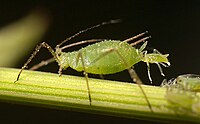
Photo from wikipedia
Anthropogenic climate change ranks among the major global-scale threats to modern biodiversity. Extinction risks are known to increase via the interactions between rapid climatic alterations and environmentally-sensitive species traits that… Click to show full abstract
Anthropogenic climate change ranks among the major global-scale threats to modern biodiversity. Extinction risks are known to increase via the interactions between rapid climatic alterations and environmentally-sensitive species traits that fail to adapt to those changes. Accumulating evidence reveals the influence of ecophysiological, ecological and phenological factors as drivers underlying demographic collapses that lead to population extinctions. However, the extent to which life-history traits influence population responses to climate change remains largely unexplored. The emerging ‘cul-de-sac hypothesis’ predicts that reptilian viviparity (‘live-bearing’ reproduction), a ‘key innovation’ facilitating historical invasions of cold climates, increases extinction risks under progressively warming climates compared to oviparous reproduction – as warming advances polewards/mountainwards, historically cold-climates shrink, leading viviparous species to face demographic collapses. We present the first large-scale test of this prediction based on multiple lizard radiations and on future projections of climate-based ecological niche models. Viviparous species were found to experience stronger elevational range shifts (and potentially increased extinctions) in coming decades, compared to oviparous lizards. Therefore, our analyses support the hypothesis’s fundamental prediction that elevational shifts are more severe in viviparous species, and highlight the role that life-history adaptations play in the responses of biodiversity to ongoing climate change.
Journal Title: Scientific Reports
Year Published: 2019
Link to full text (if available)
Share on Social Media: Sign Up to like & get
recommendations!